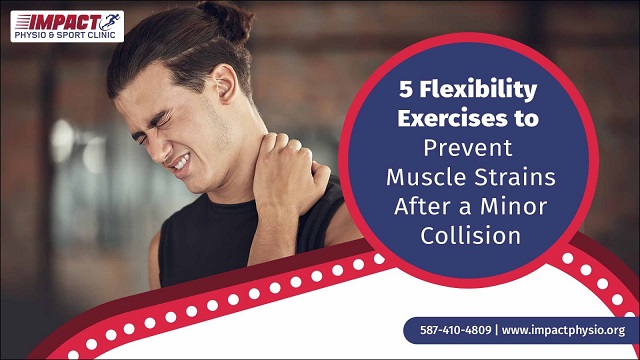A minor collision can leave you with more than just car damage. Even seemingly harmless motor vehicle accidents(MVA) can cause muscle stiffness, soreness, and the risk of muscle strains. Addressing these issues promptly is crucial to preventing long-term discomfort and maintaining mobility.
Engaging in gentle flexibility exercises can help loosen tight muscles, improve circulation, and reduce the likelihood of further strain. Motor vehicle accident physiotherapy in Beaumont provides a targeted approach to recovery by strengthening and rehabilitating affected muscles.
Why Flexibility Matters After a Minor Collision?
After a car accident, the sudden jolt your body experiences can cause muscles to tighten or spasm, leading to soreness and stiffness. If not addressed, these issues can develop into more serious strains or injuries. Flexibility exercises play a key role in:
- Minimizing muscle tension and improving range of motion.
- Promoting blood flow helps the muscles recover.
- Preventing further strain or injury during daily activities.
- Supporting proper alignment and posture may be affected by the impact of the accident.
5 Effective Flexibility Exercises for Post-Collision Recovery
MVA physiotherapy in Beaumont offers five effective exercises to help you regain flexibility and prevent muscle strains after a car accident.
1. Neck Rotations
How to Perform:
- Maintain a straight back and your shoulders relaxed, whether sitting or standing.
- Gradually turn your head to the right, aligning your chin with your shoulder.
- Hold this position for 5 seconds, then return to the center.
- Repeat the motion on the left side.
- Perform 10 repetitions on each side.
Benefits:
- Improves neck mobility and reduces stiffness caused by whiplash or sudden impact during a car accident.
- Enhances blood flow to the neck muscles, relieving tension and improving posture.
2. Shoulder Rolls
How to Perform:
- Sit or stand with your arms resting comfortably at your sides.
- Gradually roll your shoulders forward in a circular motion for 10 repetitions.
- Switch direction and roll your shoulders backward for another ten repetitions.
Benefits:
- Eases tension in the shoulders and upper back, which are often affected by seatbelt strain during a minor collision.
- Promotes flexibility and increases circulation in the shoulder joints, reducing the risk of muscle strains.
3. Cat-Cow Stretch
How to Perform:
- Begin on your hands and knees in a tabletop position, aligning your wrists beneath your shoulders and your knees beneath your hips.
- Breathe in and arch your back, raising your head and tailbone upward toward the ceiling (Cow pose).
- Breathe out and round your back, lowering your chin to your chest while pulling your belly button inward (Cat pose).
- Repeat this flow for 10 cycles, moving slowly and with control.
Benefits:
- Maximizes spinal flexibility and relieves tension in the lower back, a common issue after an MVA accident.
- Enhances posture and promotes relaxation by stretching both the back and abdominal muscles.
4. Hamstring Stretch
How to Perform:
- Sit on the floor with one leg stretched out straight in front of you and the other leg bent, placing the sole of your foot against the inner side of your thigh.
- Gradually lean forward, reaching toward your toes on the extended leg.
- Hold the stretch for 15–20 seconds without bouncing, then return to the starting position.
- Change to the opposite leg and perform the stretch again.
- Perform three repetitions on each side.
Benefits:
- Improves flexibility in the hamstrings and reduces tension in the lower back and legs.
- Prevents muscle tightness and enhances mobility, especially for those who spend long periods sitting after a car accident.
5. Child’s Pose
How to Perform:
- Start on your knees with your big toes touching and your knees spread apart.
- Sit back onto your heels, then extend your arms forward and bring your torso down toward the floor.
- Place your forehead on the floor and breathe slowly and deeply.
- Maintain this position for 20–30 seconds, then return to the starting position.
- Repeat 3–4 times.
Benefits:
- Stretches the back, hips, and shoulders, promoting overall flexibility and relaxation.
- Relieves tension caused by the stress of a minor collision and reduces stiffness in the entire body.
Importance of Motor Vehicle Accident Physiotherapy:
While flexibility exercises are an essential part of recovery, combining them with MVA physiotherapy ensures a comprehensive approach to healing. Motor vehicle accident physiotherapy in Beaumont focuses on identifying specific areas of tension or weakness caused by the accident and providing targeted treatments to restore function and prevent further issues. A physiotherapy clinic may include manual therapy, strengthening exercises, and other rehabilitation techniques to complement flexibility exercises.
Tips for Practicing Flexibility Exercises Safely:
To get the most out of your flexibility exercises and prevent muscle strains, keep these tips in mind:
- Perform stretches slowly and avoid any sudden or jerky movements.
- Never force a stretch beyond your comfort level, as this can cause injury.
- Breathe deeply and consistently during each stretch to relax your muscles.
- Listen to your body, and stop immediately if you feel sharp pain or discomfort.
- Stay consistent with your exercises, as regular practice yields the best results.
Strengthen Your Recovery with Flexibility Exercises:
Recovering from a minor collision requires more than just rest—it’s important to actively work on improving your flexibility to avoid potential muscle strains. Incorporating simple exercises like neck stretches, shoulder rolls, and the Cat-Cow Stretch can help loosen tight muscles and improve mobility. Motor vehicle accident physiotherapy in Beaumont provides a structured approach to recovery, helping you regain strength and prevent long-term complications.
Whether looking for stretches, strengthening exercises, or professional care, Impact Physiotherapy helps you regain full mobility and comfort. Take the first step toward full recovery by combining flexibility exercises with targeted physiotherapy treatments today.

